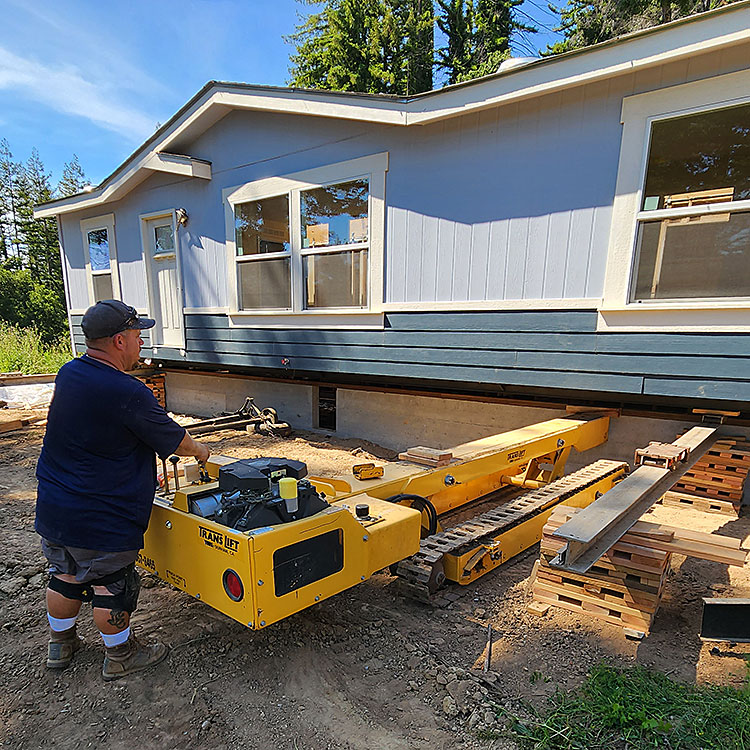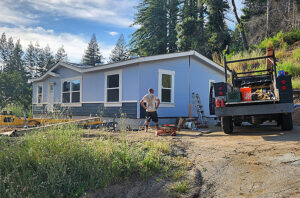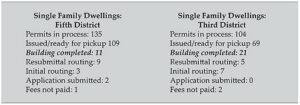By Tom Decker
It was the best of times, it was the worst of times. It was the beautiful redwood forests, it was the CZU Lightning Fires.
My wife and I live in Ben Lomond. We have six children and 21 grandchildren. We’ve been in the real estate business more than 40 years. When people in San Lorenzo Valley ask us what we do for a living, we used to say we work over the hill.
Folks in SLV don’t care too much about what goes on over the hill. This has always been just fine with us.
We’ve never, ever wanted to build any residential projects in Santa Cruz County.
Our county takes quiet pride in its well-earned reputation for being one of the most difficult counties in California in which to build.
For over 20 years, we’ve been placing high-end manufactured homes in manufactured home parks in Northern California.
Our company is based in Antioch, two hours from here, next to Suisun Bay.
In August 2020, we were forced to evacuate our Ben Lomond home as the CZU Fire approached our property. We stayed six weeks with friends in Soquel until we were able to return home.
We were greatly relieved to discover our home had survived the fire although 925 homes of our friends, neighbors and community members did not.
In the first few weeks after the fire, the Red Cross, FEMA, and people from all branches of County, State and Federal government agencies were everywhere. Many good people from community organizations and churches volunteered to help the fire victims. They gave us support, hot meals, water, clothes, good advice, blankets, tents, sleeping bags, sympathy and understanding.
Two months after the fire, things began to settle down and get back to normal — except that 1,000 families were now homeless without a clue how to rebuild.
Before the CZU Fire, the Santa Cruz County Planning and Building Departments usually permitted around 10 homes a year in our mountain communities.
Suddenly, they faced the reality of pre-clearing, permitting and allowing up to 1,000 new homes to be rebuilt. This proved to be a task far greater than anyone had anticipated.
We discovered this as we attended the many CZU Fire rebuilding meetings organized and put on by the County of Santa Cruz, FEMA, 4 LEAF and groups and gatherings of the CZU Fire victims. After a few more months, we began to wonder if there might be an easier way for folks to rebuild.
My wife made a bold decision. She said it was time to tell folks about our manufactured homes in Antioch.
For the next few months, we told people we could rebuild their home three times faster, for half cost and built better than a home built on site.
We may have told a hundred people about our homes. They had either lost their homes or knew someone who had lost theirs in the fire.
Amazingly, only two people, a senior couple, ended up making the long drive to Antioch to visit us and look at our homes. They loved our homes. But they decided to sell their Boulder Creek fire property and buy a farm in Ohio near their children. We didn’t blame them.
We altered our plan. Rather than asking people to drive to us, we brought one of our homes to downtown Boulder Creek.
In August 2021, we placed one of our homes on a parcel on Highway 9 in Boulder Creek, between the Boulder Creek Library and the Boulder Creek Volunteer Fire Department. We opened the doors in September, one year after the CZU Fire.
Within a week, we realized we would be able to rebuild only a very small number of the many hundreds of homes that needed to be rebuilt.
By November, after meeting with many fire victims and inspecting their sites, we chose a dozen families to rebuild their homes.
From that point it took us:
- two sets of structural engineers
- three heotech companies
- one licensed registered environmental engineer
- two California licensed general contractors
- three permitting consultants
- two sets soils engineers
- one topo map placement consultant
- one ancient debris flow advisor
- thirteen months and
- a 166-page plan set
… just to permit our first home.
Our first permit in the CZU Fire scar area was issued on Christmas week 2022.
Our general contractors started prepping the site the last week of December. On New Year’s Day 2023, the rains began. It rained heavily for many weeks and then a lot for a few months.
Mudslides closed the roads. Fallen trees knocked down power lines, cut off approaches. Construction material deliveries became impossible. All our construction projects halted.
About a month ago, our crews were finally able to get back to work on our sites.
At the same time China Grade was reopened.
CalTrans was then able to issue us a one-day transport permit for our home.
It took us three weeks to prep the site, build the foundation and transport the house.
The pictures tell the story.
So you may ask, what does this have to do with two cities?
Allow me to explain. We have friends who live in a beautiful home near the city pier in Fort Meyers Beach, Florida.
Last September, Hurricane Ian destroyed their home. Hurricane Ian also destroyed hundreds of other homes, many square miles of high-end residential and commercial properties — and all of the bridges and causeways.
The 150 mph hurricane winds pushed 15-foot ocean swells that destroyed everything in their path.
Ian was the most destructive hurricane in Florida’s history.
To appreciate the scope of the damage, you would have to take all the homes destroyed in our CZU Fire and then add in every structure in downtown Boulder Creek, Brookdale and Ben Lomond.
That is the scale of the devastation caused by Ian.
After Ian had destroyed these gulf cities, the Florida Highway Department worked its crews 24/7 and reopened the causeways and the bridges in less than a week.
The state of Florida set up emergency power, and food and water delivery to homeowners and construction crews working on their sites.
The state along with the local municipalities set up construction camps on public and private parcels. These camps were complete with field kitchens, sanitary facilities, showers and sleeping accommodations for hundreds.
Thousands of volunteers, construction crews and workers began pouring into Fort Meyers Beach from other states with their equipment.
The local churches set up housing facilities and accommodations for the construction workers and displaced homeowners.
Food, shelter and hot showers were available to anyone anytime at no cost.
The Florida Insurance Department allowed for private insurance adjustors to work together with the local building inspectors.
They developed an innovative process in which the insurance settlements and building permits were issued in tandem.
In some cases, they even delivered the insurance settlements and the building permits to homeowners at their construction sites.
The city’s goal was to keep the rebuilding moving forward as rapidly as possible.
Through the magic of the internet, we were able to watch our friends rebuild their home in Fort Meyers Beach. They had awesome help and support from their community and an excellent construction crew from South Carolina. They rebuilt their home and moved in by March. That was less than six months after it had been destroyed by Hurricane Ian.
The city of Fort Meyers Beach has set an ambitious goal to be 50% rebuilt by September 2023.
That’s the one-year anniversary of Hurricane Ian’s landfall.
The goal is to be completely rebuilt by September 2024.
That’s just two years after Hurricane Ian.
September 2023 is the three-year anniversary of the CZU Fire in the Santa Cruz Mountains.
In the two-and-a-half years since the CZU Fire, fewer than 55 homes have been rebuilt, compared to 925 homes destroyed.
At this rate, how many years will it take to rebuild our community?
Why was Fort Meyers Beach able to rebuild faster from Hurricane Ian than we have been able to do in Santa Cruz County?
Are there more construction supply stores in Fort Meyers Beach?
Do the people work harder there? Is the weather better? Do the workers get paid more? Inquiring minds want to know.
How is it possible that Fort Meyers Beach can rebuild 10 times faster than Santa Cruz County? It’s truly a mystery for the ages.





